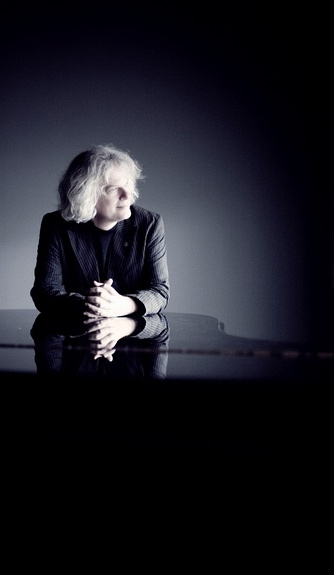Other Links
<Editorial Board
- Editor - Bill Kenny
- London Editor-Melanie Eskenazi
- Founder - Len Mullenger
Google Site Search
SEEN
AND HEARD INTERNATIONAL RECITAL REVIEW
Beethoven:
Ronald Brautigam (Piano), Herkulessaal, Munich 9.11.2007 (JFL)
Amid the frenzy of new Beethoven Sonata traversals – Paul Lewis,
HMU / Angela Hewitt, Hyperion / András Schiff, ECM / Mitsuko
Uchida, Philips / Gerhard Oppitz, Hänssler
– one stands out more then the others, and that is Ronald
Brautigam’s “Cycle++” (it will include not just the sonatas but
the complete Beethoven works for piano) for BIS. Not necessarily
because it outclasses the others in terms of playing (though from
the few discs I’ve heard it is played phenomenally well),
but because he uses his own fortepiano for it. (Volumes
One,
Two,
Three,
Four, and
Five have been reviewed on MusicWeb International.)
Beethoven: Sonata E-flat Major, op.7
Beethoven: Sonata B-flat Major, op.22
Beethoven: Six Bagatelles, op.126
Beethoven: Sonata f minor, op.57

Ronald Brautigam
Anyone who has followed Brautigam’s career on disc or in recital
knows that the fortepiano is no mere gimmick. Brautigam plays it
because he believes that it gets him closer to the composer. If
the listener can partake in that – via the struggle, the overall
sound, the efforts needed to create certain sounds etc – then all
the better. In a recent interview he explains that if the composer
writes ugly music, you have to play it ugly, too. And if the
audience doesn’t like it, then so be it. He is adamant about not
using a work for a purpose but making the purpose fit the work at
hand. Or not play it at all.
And he adds intriguingly, he’d rather be a ‘sound-museum’
than an entertainer.
This is either a fair warning to anyone who plans to attend a
recital or added interest, depending on how you feel about
classical music and/or ‘authenticity’. But at the recent Munich
recital, organized by
Winderstein Konzerte, that point was rather (and sadly) mute,
because Brautigam did not travel with his fortepiano: instead
played the Steinway concert grand of the Herkulessaal.
If I had had my eyes closed, I might not have noticed for a while,
because in the opening movement of the E-flat Major sonata op.7,
Brautigam made the piano less like you’d expect it to, being
played like a Hammerklavier but more as if to
approximate its sound. The playing was ‘pebbled’, with quickly
decaying notes, and an awfully odd sounding middle register. The
contrasts in the slow movement – now sounding like a regular
instrument again with all the languor that it offers – were
heightened by contrasting timbres and the caressing of every break
and pause as if the score were littered with little fermatas. The
third movement Allegro saw more contrasts, single notes and chords
expanded – sometimes at the expense of the whole. Tender if
necessary but never dainty, there was something brawny – but not
bold – about this early Beethoven in the hands of Brautigam;
something impetuous, self-conscious.
Op. 22 can get the performer (and listener) quite carried away
with its affecting opening movement. Brautigam resisted that
temptation and showed some brilliance and speed that might be in
part honed by the fortepiano playing. Rhythmical oddities made the
Adagio a tad curious to listen to. Lovely, but not allowing
for true sweetness. That might be refreshing, as such, but the
energy with which Beethoven struts through this movement was
sapped. Beethoven was interrupted, not helped here. The lively Menuetto and a fine closing Rondo pacified, but were in the latter
case, not given the steely clarity and ‘objectivity’ that other
pianists score here.
The mixed first half was in any case, overshadowed by a first-rate
second half. Whether you think that Beethoven’s last important
work for piano – the Six Bagatelles op.126 – are truly
wonderful late Beethoven, or rather modest, anticlimactic addenda
to op.111 and the Diabelli Variations, there was no denying
the excellence of Brautigam’s interpretation of these wildly
varying six movements - nor the delight in hearing these
rarely performed pieces live and presented with such obvious
passion. I found myself veering between the two descriptions, but in
recital I also found many things wonderful in hidden ways about
the performance; and one quirky detail that might amuse.
Listen closely to the second Bagatelle, Allegro, and see if you
haven’t heard the dominant right hand figure at a little over one-
and again a bit over two - minutes into the piece somewhere
before. Yep, that’s right – it’s the title jingle from the Batman
TV series; the “Da-da-Da-da-Da-da-Da-da” part before the
“BAT-MAAAN” exclamation. Once it becomes obvious, it is difficult
to suppress giggles in concert. I managed, barely, and listened to
the meandering through stormy wild, tamed, dark and menacing,
bright and fun sections – appreciating the work more, bagatelle by
bagatelle.
Should anyone have expected understatement from the often exciting
but never quite wild Ronald Brautigam, then he had a surprise in
store with the Appassionata sonata. I’ve heard it
faster but not by much, and
sloppier and more exaggerated - but then usually not to the
desired effect. Here it was a fine combination of speed and
emotion, relentless, mildly blurred and with frightful runs,
devoutly hammered-out chords in the first movement and then more
explosiveness and a pointed attack in the third. Only the second
movement Andante con moto struck as plodding a bit, undermining
the incredibly charming back and forth between the hands that
follows the introduction of the upper voice.
Like any good artist, Brautigam left one desiring more, even
without convincing entirely. And he gave a little more, too.
Had he not been on an all-Beethoven kick, I might have thought the
encore was some unknown Schumann or Mendelssohn bonbon. Alas,
home-listening confirmed that it was the lullaby-inspired and
-quoting - very pretty, slow movement of Sonata No.25, op.79
Jens F. Laurson
Picture © Marco Borggreve
